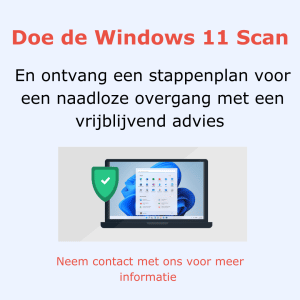Mededelingen en Aanbiedingen
Bekijk hieronder de lopende aanbiedingen en mededelingen. Heb je vragen over onderstaande mededelingen of aanbiedingen? Neem gerust contact met ons op.
Bekijk hieronder de lopende aanbiedingen en mededelingen. Heb je vragen over onderstaande mededelingen of aanbiedingen? Neem gerust contact met ons op.
Bekijk hieronder onze lopende aanbiedingen en doe je voordeel!

Ga je binnenkort over naar Windows 11? De Windows 11 scan inventariseert je hardware en software. Kan je hardware het aan om Windows 11 te gebruiken? Blijven al je applicaties werken? De Windows 11 Scan draait op de achtergrond en geeft een overzicht van je complete hardware en applicatie landschap. Op basis van onze bevindingen geven wij een vrijblijvend advies voor een soepele, probleemloze overgang naar Windows 11 zonder dataverlies.
Klik hier voor meer informatie.
Vorig jaar steeg het aantal gemelde ransomware-aanvallen wereldwijd met 715 procent, meldde een beveiligingsbedrijf.
En uit een onderzoek van Beazly Breach Response blijkt, dat 71 procent van alle ransomware-aanvallen gericht is op mkb-bedrijven.
Hoe cyberbewust is jouw bedrijf? Doe hier de gratis test bestaande uit 10 vragen en krijg direct inzicht in jouw bedrijfsveiligheid!

Wiersedreef 10
3433 ZX Nieuwegein
Algemeen: 030 6000 600
Servicedesk: 030 6000 601
Privacybeleid
Algemene voorwaarden
KvK: 30116011
BTW nr: NL80.95.65.031.B.01
Hartelijk dank voor jouw interesse in een ICT Beheer pakket! Laat je gegevens achter en we nemen binnen 1 werkdag contact met je op.
Hartelijk dank voor jouw interesse in een ICT Beheer pakket! Laat je gegevens achter en we nemen binnen 1 werkdag contact met je op.
Hartelijk dank voor jouw interesse in een ICT Beheer pakket! Laat je gegevens achter en we nemen binnen 1 werkdag contact met je op.
Wij kunnen je hier zeker mee helpen! We nemen zo spoedig mogelijk contact met je op.
Het Fastbyte team
Maakt ICT behapbaar!
INPUT YOUR SPECIFIC NEEDS IN THE FIELDS BELOW FOR THE MOST ACCURATE INFORMATION. HOVER OVER THE QUESTION MARKS FOR MORE INFORMATION
?
In order to give your clients you a correct calculation we need to get an idea of how much data you have in your clients'your systems across theiryour organization.GB
?
What is the timeframe between each of your clients' your backups? E.g. every hour, once a day, once a week.?
From when disaster strikes, how long does it for your end user to notify you, for you to assess the situation, access your backups, and start the recovery process? Think of this a your reponse time.?
Storing your data locally is designed for fast data transfers, however you are at risk if there is a disaster in the office such as fire, floods or theft. Cloud data is stored off-site, such as in a Datto data center, which brings an extra level of availability albeit at a slower speed for full bare metal restores.?
Speed of cloud recovery comes down to the amount of data you are trying to recover and your download speed. Devices with slower connections will take longer to recover.Mbps
?
Nearly every employee will be impacted by an IT outage and will not be able to perform their job obligations to a certain degree. We recommend including the entire staff in this field.?
Even if the business stops due to an outage and employees are not able to perform some, or all, of their duties, employee wages typically are still paid. We are assuming yours will need to be paid, and this must be included in your cost of downtime calculations.{{currencyicon}}
?
All staff come with overhead costs like, gas, electric, rent, etc. Normally, this is about 50% of the average salary.{{currencyicon}}
?
For most businesses, an outage will halt the ability to product and accrue revenue. We are assuming that your revenue will case during an outage, and so annual revenue helps to calculate the average cost of lost revenue during downtime.{{currencyicon}}
?
It's critical to regularly test your backups. In the case that a backup isn't working, you could be looking at additional losses of {{perbackupdowntime}} per failed backup.Time between backups
?
This is the time it takes for your data to actually be downloaded back to your original device based on your backup location. Local backups will be quicker, but because a local disaster could take out local backups, but it’s always vital to ensure that you have a cloud backup as well.Recovery Processing Time
?
If you experience a ransomware attack, you may be able to recover quickly. If you're faced with a fire or flood, you could be offsite for days and face higher costs than what you see here. The results below are estimates for a local backup with a data transfer speed of around 500MB/sSummary
?
Datto's SIRIS BCDR solutions allow you to backup as frequently as every 5 minutes. They also allow for regular testing and validation of your backups, reducing your risk even further.Time between backups
?
In case of a disaster, Datto can enable you to virtualize your backups, hosted in our cloud. On average, it only takes about {{bcdrrecovery}} minutes to access the Datto portal, find your backup copy, and to virtualize it.Average Recovery Processing Time
?
Downtime will always cost your business money. However, you can reduce it with a Datto business continuity/disaster recovery solution. Compared to your current solution, you could reduce your possible downtime losses by around {{ localcostsaving }} {{ cloudcostsaving }}Summary
With the information that you've provided, and using certain assumptions made based on how businesses today typically function, we have estimated your clients'your downtime losses to be {{displayhourlyRevenueCost}} per hour Calculation is made by taking Staff Salary, Overheads & Revenue and breaking that down to an hourly cost for a 40 week & 52 weeks of the year business, then multiplied by the number of staff..
With your clients'your current backup & recovery solution you could be looking at a estimated potential loss of around {{ localdowntimecost }}{{ clouddowntimecost }}Hourly Cost ({{displayhourlyRevenueCost}}) * Estimated Downtime ({{ displaylocalDowntime }}{{ displaycloudDowntime }}) due to {{ displaylocalDowntime }}{{ displaycloudDowntime }} of downtime. This is assuming that your clients'your recovery process works exactly as planned, and could be worse if you experience any further glitches. For this reason, it's critical to regularly test your clients'your recovery capabilities. If the recovery process fails, your clientsyou could be looking at additional losses of {{perbackupdowntime}} Estimated Downtime Cost per hour ({{displayhourlyRevenueCost}}) * Time between Backups ({{backuphrs}}hrs {{backupmins}}mins) per recovery attempt.
With the information that you've provided, and using certain assumptions made based on how businesses today typically function, we have estimated your clients'your downtime losses to be {{displayhourlyRevenueCost}} per hour.
With your clients'your current backup & recovery solution you could be looking at a estimated potential loss of around {{ localdowntimecost }}{{ clouddowntimecost }} due to {{ displaylocalDowntime }}{{ displaycloudDowntime }} of downtime. This is assuming that your clients'your recovery process works exactly as planned, and could be worse if you experience any further glitches. For this reason, it's critical to regularly test your clients'your recovery capabilities. If the recovery process fails, your clientsyou could be looking at additional losses of {{perbackupdowntime}} per recovery attempt.
With the information that you've provided, we have identified that your clients'your estimated downtime losses per hour would be {{displayhourlyRevenueCost}}. However, as a result of not taking data backups the impact could be much worse!
Local backups should be a key part of your data protection strategy for your clients. They allow you to recover data and restore operations quickly in the event of a primary server outage, data deletion, or a ransomware attack. However, local backup alone isn't enough. What happens if the local backup device is destroyed or inaccessible due to a fire, flood, or other disaster? That's why you need a secondary, offsite copy of backups.
Cloud backup delivers that secondary, geographically isolated copy. You might ask? Why do I need local backups at all? Well, restores from the cloud are slow. That’s why the combination of onsite backups with cloud replication has become so popular among SMBs and MSPs alike. You really need both—local for fast restores and cloud for disaster recovery.
In contrast,The first step is to talk to your IT service provider or MSP about Datto. Datto's SIRIS business continuity and disaster recovery (BCDR) solutions could reduce your clientsyour downtime to {{displayBCDRDowntime}} and thieryour overall downtime cost would fall to {{ bcdrdowntimecost }}. In the rare case that the first recovery attempt doesn't work, your costs would only increase by {{perdattobackupdowntime}}, as opposed to {{perbackupdowntime}}{{perbackupdowntime}}your businesses closing all together.
With Datto, even if you are experiencing an outage at your workplace, work doesn't have to stop. Datto Continuity can get you back to business in a little as {{bcdrrecovery}} minutes on virtual servers, which can be accessed anywhere you have working internet. Features like Ransomware Detection and Advanced Backup Verification let you rest easy knowing your backups will work in your time of need.
Hartelijk dank voor jouw interesse in een Fujitsu Thuiswerkpakket! Laat je gegevens achter en we nemen binnen 1 werkdag contact met je op.
/
